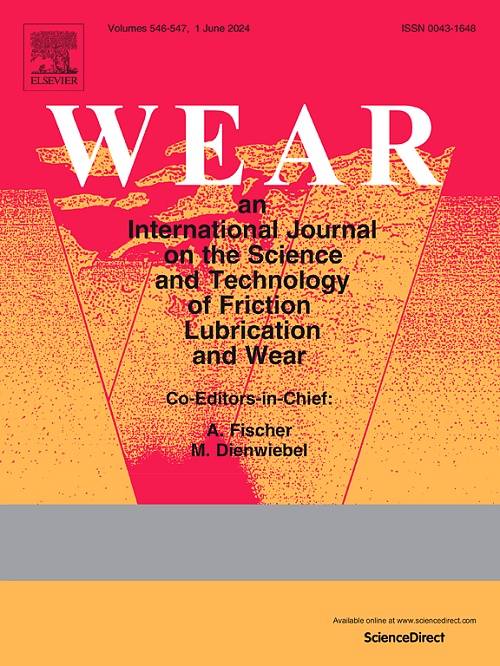Experimental investigation on the slurry erosion and corrosion characteristics of friction stir welded AA5052 in the marine environment
IF 6.1
1区 工程技术
Q1 ENGINEERING, MECHANICAL
引用次数: 0
Abstract
Materials with superior strength-to-weight ratio and corrosion resistance, such as aluminum alloy (AA5052), are favored in marine applications. Friction stir welding of these alloys can help create flawless joints. These alloys during maritime applications, are subjected to erosion and corrosion caused by the salt and sand in the water, and the non-welded and welded regions undergo variable levels of erosion and corrosion. Therefore, the erosion that the AA5052 experiences in the maritime environment is examined in both cast and friction stir welded (FSW) conditions in the present work. The potentiodynamic-polarization along with immersion-technique is used to evaluate the corrosion resistance of both cast and FSW aluminum alloy samples. The results revealed that the FSW sample possessed a 12 times higher corrosion rate than the cast, which is contributed by the refined grains and intermetallic phases like Al3Fe in it. The erosion test is executed using a pot-type slurry erosion tester using sand and 3.5 % saline water as a slurry at slurry concentrations of 100, 300, and 500 g/L and slurry speeds of 500, 1000, and 1500 rpm while maintaining slurry particle size, slurry temperature, and slurry pH constant. The FSW sample displayed only a marginal erosion resistance when compared to the cast whereas the erosion rate in both enhanced at higher slurry speeds and slurry concentrations. In both the cast and FSW samples, the material removal is triggered by the plastic deformation caused by the impinging sand particle's kinetic energy. An increase in slurry concentration from 100 to 500 g/L and slurry speed from 500 to 1500 rpm enhanced material removal to about 95 % and 400 % respectively.
搅拌摩擦焊AA5052在海洋环境中料浆冲蚀及腐蚀特性的试验研究
具有优异强度重量比和耐腐蚀性的材料,如铝合金(AA5052),在船舶应用中受到青睐。这些合金的搅拌摩擦焊接可以帮助创造完美的接头。这些合金在海上应用时,会受到水中盐和沙子的侵蚀和腐蚀,而非焊接和焊接区域则会受到不同程度的侵蚀和腐蚀。因此,在本工作中,研究了AA5052在铸造和搅拌摩擦焊接(FSW)条件下在海洋环境中经历的侵蚀。采用动电位极化结合浸没技术对铸铝合金和搅拌铸造铝合金试样的耐蚀性进行了评价。结果表明,FSW试样的腐蚀速率是铸态试样的12倍,这主要是由于试样中存在细化晶粒和Al3Fe等金属间相。在保持泥浆粒度、温度和pH值不变的情况下,采用砂和3.5%盐水作为泥浆,分别以100、300和500 g/L的浓度和500、1000和1500 rpm的速度进行侵蚀测试。与铸体相比,FSW样品仅显示出边际抗侵蚀能力,而在更高的泥浆速度和泥浆浓度下,两者的侵蚀速率都有所提高。在铸态和FSW试样中,材料的去除都是由撞击砂粒的动能引起的塑性变形触发的。浆液浓度从100 g/L增加到500 g/L,浆液速度从500转到1500转,分别使材料去除率提高到95%和400%左右。
本文章由计算机程序翻译,如有差异,请以英文原文为准。
求助全文
约1分钟内获得全文
求助全文
来源期刊

Wear
工程技术-材料科学:综合
CiteScore
8.80
自引率
8.00%
发文量
280
审稿时长
47 days
期刊介绍:
Wear journal is dedicated to the advancement of basic and applied knowledge concerning the nature of wear of materials. Broadly, topics of interest range from development of fundamental understanding of the mechanisms of wear to innovative solutions to practical engineering problems. Authors of experimental studies are expected to comment on the repeatability of the data, and whenever possible, conduct multiple measurements under similar testing conditions. Further, Wear embraces the highest standards of professional ethics, and the detection of matching content, either in written or graphical form, from other publications by the current authors or by others, may result in rejection.
 求助内容:
求助内容: 应助结果提醒方式:
应助结果提醒方式:


